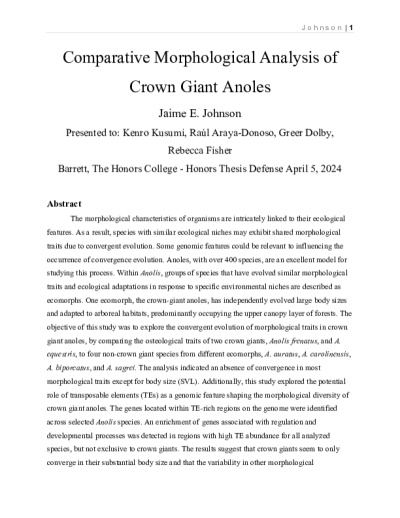Matching Items (2)
Filtering by
- Status: Published

Description
Vertebrate genomes demonstrate a remarkable range of sizes from 0.3 to 133 gigabase pairs. The proliferation of repeat elements are a major genomic expansion. In particular, long interspersed nuclear elements (LINES) are autonomous retrotransposons that have the ability to "cut and paste" themselves into a host genome through a mechanism called target-primed reverse transcription. LINES have been called "junk DNA," "viral DNA," and "selfish" DNA, and were once thought to be parasitic elements. However, LINES, which diversified before the emergence of many early vertebrates, has strongly shaped the evolution of eukaryotic genomes. This thesis will evaluate LINE abundance, diversity and activity in four anole lizards. An intrageneric analysis will be conducted using comparative phylogenetics and bioinformatics. Comparisons within the Anolis genus, which derives from a single lineage of an adaptive radiation, will be conducted to explore the relationship between LINE retrotransposon activity and causal changes in genomic size and composition.
ContributorsMay, Catherine (Author) / Kusumi, Kenro (Thesis advisor) / Gadau, Juergen (Committee member) / Rawls, Jeffery A (Committee member) / Arizona State University (Publisher)
Created2013

Description
The morphological characteristics of organisms are intricately linked to their ecological features. As a result, species with similar ecological niches may exhibit shared morphological traits due to convergent evolution. Some genomic features could be relevant to influencing the occurrence of convergence evolution. Anoles, with over 400 species, are an excellent model for studying this process. Within Anolis, groups of species that have evolved similar morphological traits and ecological adaptations in response to specific environmental niches are described as ecomorphs. One ecomorph, the crown-giant anoles, has independently evolved large body sizes and adapted to arboreal habitats, predominantly occupying the upper canopy layer of forests. The objective of this study was to explore the convergent evolution of morphological traits in crown giant anoles, by comparing the osteological traits of two crown giants, Anolis frenatus, and A. equestris, to four non-crown giant species from different ecomorphs, A. auratus, A. carolinensis, A. biporcatus, and A. sagrei. The analysis indicated an absence of convergence in most morphological traits except for body size (SVL). Additionally, this study explored the potential role of transposable elements (TEs) as a genomic feature shaping the morphological diversity of crown giant anoles. The genes located within TE-rich regions on the genome were identified across selected Anolis species. An enrichment of genes associated with regulation and developmental processes was detected in regions with high TE abundance for all analyzed species, but not exclusive to crown giants. The results suggest that crown giants seem to only converge in their substantial body size and that the variability in other morphological characteristics could be attributed to some other ecological features or the phylogenetic relationships of each species. Moreover, TEs may play a role in facilitating morphological evolution and adaptability in all Anolis species, as they could influence gene expression and regulatory pathways. This highlights the need for further investigation into the genomic mechanisms determining convergent evolution.
ContributorsJohnson, Jaime (Author) / Kusumi, Kenro (Thesis director) / Araya-Donoso, Raúl (Committee member) / Dolby, Greer (Committee member) / Fisher, Rebecca (Committee member) / Barrett, The Honors College (Contributor) / School of Life Sciences (Contributor)
Created2024-05